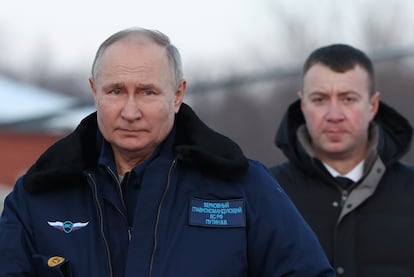Putin orders non-strategic nuclear exercises in response to ‘threats’ from the West
The Kremlin said any discussion of deploying NATO troops in Ukraine represented ‘a completely new round of escalation of tension; it is unprecedented, and of course it requires special attention and special measures’


Russia’s president and supreme commander-in-chief of the country’s armed forces, Vladimir Putin, has ordered his military to conduct exercises involving its non-strategic nuclear forces, the second line of its arsenal in terms of destructive capability and capable of delivering a first strike in a hypothetical conflict with the West. The Kremlin argues the move comes in response to proposals by some Western leaders to deploy troops in Ukraine. “The exercise is aimed at maintaining the readiness of personnel and equipment of units for the combat use of non-strategic nuclear weapons in order to unconditionally ensure Russia’s territorial integrity and sovereignty in response to provocative statements and threats from Western officials,” the Russian Defense Ministry said in a statement Monday. The announcement, a warning signal, also comes after French President Emmanuel Macron raised the use of the nuclear force Paris possesses as a deterrence tool to protect its European partners.
The Kremlin issued the threat in a symbolic week: Putin will be inaugurated for a new presidential term on May 7 and two days later, May 9, is a date sacred to Russia: Victory Day, the anniversary of the Soviet triumph over Nazi Germany.
Kremlin spokesman Dmitry Peskov specified that Putin’s order responds to statements made by Macron, British Foreign Minister David Cameron, and U.S. officials. Peskov said that any discussion of deploying troops from NATO member states in Ukraine represented “a completely new round of escalation of tension; it is unprecedented, and of course it requires special attention and special measures.”
The missile formations of the Russian southern military district will coordinate with the air force and navy to “practise the issues of preparation and use of non-strategic nuclear weapons,” the Defense Ministry said. Although the Kremlin’s official military doctrine envisages using its 6,000 nuclear warheads only if “the very existence of the Russian Federation is under threat,” the military high command also has the option of launching tactical and less powerful nuclear weapons to achieve its objectives by instilling fear in its enemies. This strategy, which has been on the table since Putin came to power in the early 2000s in the face of NATO’s technological superiority, has been called “escalate to de-escalate.”
The French president mentioned a taboo subject for NATO last February: deploying troops inside Ukraine. Although the Elysée later clarified that it would only be a question of military advisors for the Ukrainian army, Macron insisted again on May 2 on the possibility of sending Western troops “if the Russians were to break through the front lines, if there were a Ukrainian request, which is not the case today.”
For his part, David Cameron said last week in an interview with Sky News that reinforcing Ukrainian forces with Atlantic Alliance soldiers would be a “dangerous escalation.” Moscow, however, accuses London of straining the situation by authorizing Kyiv to fire the long-range weapons it has supplied against enemy military groups and infrastructure inside Russian territory.
Kyiv drone attacks hit Russian gasoline exports
Ukraine is awaiting the arrival of ammunition stocks promised by the U.S. and U.K., but continues to fight its war for existence with its own means. Hit by an unprecedented Ukrainian drone offensive against its refineries, Russian exports by ship of oil derivatives plummeted in April by more than 20% compared to the same month in 2023, and by more than 11% compared to March. The new Ukrainian strategy has taken its toll on Moscow, whose foreign sales of fuel oil and gasoline fell to their lowest level since consultancy Kpler began tracking its market in 2017.
Kyiv initiated a bombing campaign against the Russian oil industry in March to strike at one of the Kremlin’s main sources of income. The aim of Ukrainian President Volodymyr Zelenskiy is to intensify the difficulties Russia is experiencing in maintaining its refineries in the face of the shortage of spare parts caused by Western sanctions. According to estimates by the Russian state statistics agency, Rosstat, production of petroleum products had fallen by more than 10% since the attacks began up to mid-April.
Ukrainian attacks have targeted refineries deep in Russia’s European zone. In March alone, facilities in far-flung regions such as Nizhny Novgorod, Samara, Oryol, Ryazan, Rostov and Leningrad, some bordering Finland and others in the Caucasus, were hit.
Kpler’s data show that fuel oil exports by ship were down 24% year-on-year in April as a whole and 11% as of March this year, to 815,000 barrels per day. Meanwhile, gasoline seaborne exports were down 20% and 15%, respectively, to 322,000 barrels per day. In the case of diesel, of which Russia was selling more than one million barrels per day as of February, its exports plunged to 762,000 barrels, down 28% year-on-year and 23% from the previous month.
“The situation is not critical because the oil can be diverted to other refineries that operate at 75% or 80% of their capacity,” Stanislav Mitrakhovich, an expert at the Russian National Energy Security Fund, told this newspaper by telephone, although he stressed that this measure will be a headache for Russian rail transport and Ukrainian attacks may have an impact on the price of products inside the country.
The Kremlin has banned the export of gasoline between March 1 and August 1 to prevent a price escalation in the domestic market. “The downside is that companies and the government make quite a lot of money from gasoline exports,” says Mitrakhovich, who does not rule out the risk of a rise in fuel prices “in the summer, when there will be an increase in demand for gasoline, although so far it has not had a terrible impact.”
Sign up for our weekly newsletter to get more English-language news coverage from EL PAÍS USA Edition
Tu suscripción se está usando en otro dispositivo
¿Quieres añadir otro usuario a tu suscripción?
Si continúas leyendo en este dispositivo, no se podrá leer en el otro.
FlechaTu suscripción se está usando en otro dispositivo y solo puedes acceder a EL PAÍS desde un dispositivo a la vez.
Si quieres compartir tu cuenta, cambia tu suscripción a la modalidad Premium, así podrás añadir otro usuario. Cada uno accederá con su propia cuenta de email, lo que os permitirá personalizar vuestra experiencia en EL PAÍS.
¿Tienes una suscripción de empresa? Accede aquí para contratar más cuentas.
En el caso de no saber quién está usando tu cuenta, te recomendamos cambiar tu contraseña aquí.
Si decides continuar compartiendo tu cuenta, este mensaje se mostrará en tu dispositivo y en el de la otra persona que está usando tu cuenta de forma indefinida, afectando a tu experiencia de lectura. Puedes consultar aquí los términos y condiciones de la suscripción digital.
More information
Archived In
Últimas noticias
‘How does it feel to be a failure?’: Elizabeth Berkley’s journey from ‘Showgirls’ ridicule to vindication
The story of the Málaga virus: The code that haunted Google’s cybersecurity center director for 30 years
The impact of Ecuador’s mega-prison: A polluted river, cleared forests and military checkpoints
Corinne Low: ‘I’m more concerned about the female happiness gap than the gender wage gap’
Most viewed
- The low-cost creative revolution: How technology is making art accessible to everyone
- Christian Louboutin: ‘Young people don’t want to be like their parents. And if their parents wear sneakers, they’re going to look for something else’
- All the effects of gentrification in one corner of Mexico’s Colonia Roma
- Liset Menéndez de la Prida, neuroscientist: ‘It’s not normal to constantly seek pleasure; it’s important to be bored, to be calm’
- Christmas loses its festive spirit: ICE fears cast shadow over religious celebrations










































